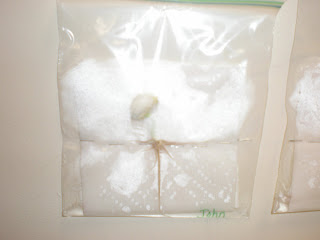
Our first two units that we study about in science are being a scientist and plants. Here we are combining the two, by designing an experiment with plants. Here are the beginnings of our experiments. Some of us are having a seed race, some used salt water and sugar water, some varied the amounts of water, some are testing natural light and fluorescent light, some are testing light and dark, and some are testing soil, sand, and rocks.
To get our experiments set up we made a plan with the question we are testing, the materials needed, the steps in the procedure, and a hypothesis. We can't wait to see what our results will be!
 We were thrilled to come in from the weekend and see growth in our experiments! Here we are conferring with our partner(s) about the experiment. Breckin and Abby (above) are looking at the difference between a plant in the light and in the dark. Alex is doing a great job of taking notes of his observation in his journal. Diego and Haley and Jenna and Tyler decided a ruler might be a good tool to help with the specifics of their experiment. We can't wait to see what will happen next!
We were thrilled to come in from the weekend and see growth in our experiments! Here we are conferring with our partner(s) about the experiment. Breckin and Abby (above) are looking at the difference between a plant in the light and in the dark. Alex is doing a great job of taking notes of his observation in his journal. Diego and Haley and Jenna and Tyler decided a ruler might be a good tool to help with the specifics of their experiment. We can't wait to see what will happen next!































